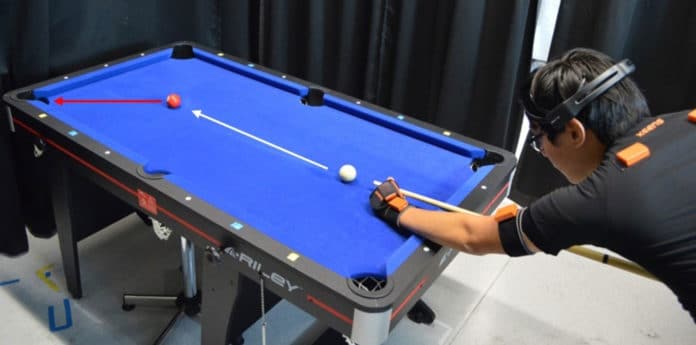In a new study, Professor Aldo Faisal and Dr. Shlomi Haar at Imperial‘s Brain and Behaviour lab have taken neuroscience into the real world. Using pool-billiards, scientists analyzed full-body movement during motor learning.
This study demonstrated the whole body’s involvement in the learning process and identified the critical joint movement for learning.
In particular, scientists used wearables for naturalistic full-body motion-tracking and the sports of pool billiards to frame a real-world skill learning experiment.
They placed sensors across the bodies of 30 individuals who were learning to play pool billiards for the first time. The sensors recorded the limbs and torso’s movements, and their data was uploaded onto a computer for analysis.
The data from the sensor helped scientists reconstruct the movement of the full skeleton as an avatar. Also, it enabled accurate analysis of the movement in every single joint and the holistic, or whole-body, movement.
When they measured whole-body movements, they discovered that learning happens from head to toe: even though the main movement was in the arm’s elbow holding the cue stick, as is to be expected with pool, the whole body changed and improved its motor learning. This data-driven approach to neuroscience adds more detail to what we think about motor learning, showing a whole-body experience.
Lead researcher Professor Aldo Faisal of the Departments of Computing and Bioengineering said: “Learning pool doesn’t require pre-existing technical expertise, so it was a good way to measure how humans learn a new skill. We found that when you are learning a new dexterous skill, every part of the body is learning.”
However, the point should be noted that learning mechanisms differ from person to person; each person learns motor control differently. Of the 30 participants completing the same task, two types of learners use different learning mechanisms.
Professor Faisal said: “Each of these participants had a predominant learning method. Only once we introduce subjects with the complexity of the real-world do we see that each person is different, and seeing what different mechanisms come out.”
Understanding how learning between the joints and across the whole body takes place has translational potential in rehabilitation learning and sports science.
Co-author Dr. Shlomi Haar of Imperial’s Department of Brain Sciences said: “This real-world approach to neuroscience shows that we don’t have to manipulate the world to find what we are looking for. Instead, we can observe the world and extract meaning from people’s movement and brain activity as they go about their real-world tasks and display free behavior.”
“The way the data unfolded told stories – stories about learning across the body, and stories of different learning mechanisms. This demonstrates the value of testing in the real world.”
Journal Reference:
- Haar, S., van Assel, C.M. & Faisal, A.A. Motor learning in real-world pool billiards. Sci Rep 10, 20046 (2020). DOI: 10.1038/s41598-020-76805-9
